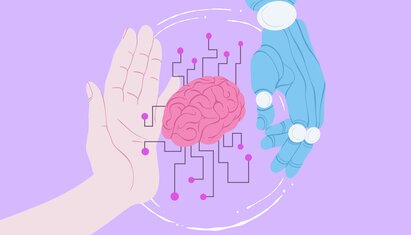The 6 emerging trends shaping therapy in 2026



Published October 1, 2020

In the next ten years, the field of social work is projected to grow 13 percent. Substance abuse and mental health social workers are expected to grow 17 percent—significantly faster than any other field. So what’s driving this growth?
As current events unfold, the work performed by social workers has proven to be fundamental to a functioning society. As schools begin to introduce more trauma-informed care for their students and educators, social workers will need to lead the way. By 2050, there’ll be more than 80 million people over the age of 65 that will require a social worker’s skill-set. As the demand for social work grows, the field is pressed to accommodate for it.
Young graduates from social work programs are among the most diverse. More women and people of color graduated in 2018 with advanced degrees in social work than most other fields. In the same year, the majority of graduates with both bachelors and masters degrees in social work were between the ages of 21 and 30. Millennials, it seems, are drawn to this profession.
More than any other generation, millennials value flexibility in their careers. They want jobs that they can do from anywhere and that’ll offer them an incentive to continue to do impactful work. And they’re more likely to leave a job to find those opportunities elsewhere.
Because social workers have so many avenues available to them—working with children, families, people with substance abuse disorders, and the elderly—graduates of social work degree programs leave school feeling like they have options. And with those options comes the opportunity to impact the most people, even if it’s in a different way than when they started.
Melissa Douglass, LCSW, BC-TMH got her masters in social work in 2012, and she’s already seen the industry shift to keep up with society’s progress. “Social work has changed quite a bit even since I started, and I see it changing even more in the future,” she says. The increased use of technology, including social media, means that social workers’ reach is greater than ever before—just as the demand for their work continues to increase.

Social media has undeniably changed the way we interact with the world around us, and that change affects almost everyone. Social workers need to be more aware than ever of the content their clients are consuming—and when they’re consuming it. “I don’t think social media has necessarily changed the profession itself, but it has invited a greater focus on our ethics and responsibilities,” Douglass says. “News spreads fast now, and that’s not something we had even just a few years ago.”
In recent months, many people have increased their social media consumption as a result of societal trends, and more recently, quarantine. This uptick has resulted in a serious ripple effect on mental health across the nation. In 2020, one in four adults are experiencing “serious mental distress.” That’s eight times more people than just two years ago.
It’s even worse for young adults. Eighteen to twenty-nine-year-olds, who are prime social media users, reported a 967 percent increase in “serious mental distress” in the past two years. A lot of that increase can likely be attributed to COVID-19, but the data goes back to 2018—well before the first cases were reported.
Although social media isn’t causing the global health crisis or civil unrest that’s dominated the news cycle in recent months, constant access to bad news from around the globe isn’t helping anyone sleep better at night. It’s become such an issue that it’s even gotten its own name: doomscrolling.
In the face of such widespread and instantly available information, practitioners need to be aware of what their clients might be seeing and how it may affect them. “In certain instances, we’re seeing how it can actually be traumatic as people are reading about and watching videos of these events,” Douglass says.
Douglass goes on to explain, “We’re dealing with a lot more secondary trauma. That just increases our responsibility as care providers to be present, and to get ready to provide service for people who are affected on a wider scale than ever before.”
It’s easy to dismiss all technology as having the same adverse impact on society’s mental health. But as living and working in a pandemic has shown, the use of technology is actually beneficial—and for some people, necessary.
As a practitioner who has run a totally virtual practice for more than three years, Douglass knows first-hand how valuable telehealth can be to people who need it the most. She’s just glad everyone else is finally getting the message.
“Telehealth isn’t new at all. It just wasn’t supported on a larger level until we had a global pandemic and had no choice,” she says. “I think everyone’s realized that now that we’ve introduced this and proven it works, it may not be the most ethical thing to take it away from people.”
In the early months of COVID-19, insurance companies started extending temporary coverage for telehealth visits, and the CARES Act passed by Congress included provisions for expanding telehealth as well. As Douglass says, now that everyone has seen how well telehealth can work, there’s a growing movement to make these temporary changes permanent.
Access to telehealth isn’t just about convenience or cutting down on travel time. It’s about equality of access for everyone. Rural communities have been relying on telehealth for years as they navigate issues like physician shortages and physical distance from specialists.
For Douglass, telehealth is just one example of how the field of social work is trying to bring some of their more antiquated practices up to speed. “There needs to be genuine commitment to systemic change. And now that we’ve done these things temporarily, we need to figure out a permanent solution. That’s how we make it possible for everyone to have equal access to the care and services they need,” she explains.

As a telehealth expert, Douglass says that when the pandemic hit she went “straight into fight mode. We had a nation of providers trying to figure this all out in just a matter of days, so I jumped right into helping people figure it out.”
Professionals in every field had to figure out how to live and work in a pandemic in rapid succession. For mental health and medical care providers, all those experiences were—and still are—happening twice.
“There’s been a big shift in the understanding of how vicarious trauma affects us as providers. Now, we all need to keep figuring out what effective self-care looks like for us,” Douglass says. “Because we’re experiencing a lot of these things while our clients are experiencing them, and we still have to find a way to take care of everyone.”
Even before COVID-19, studies showed that first responders reported high rates of PTSD, depression, anxiety, and suicidal thoughts. Frontline healthcare workers who have been working through the pandemic are already showing similar signs. And those numbers will undoubtedly continue to grow over time.
“It’s our job to help other people first,” Douglass says. “That doesn’t mean we don’t build in some time for our own self-care, but it’s just not the main focus of our day. For me, I had to make a change and recognize that I’ve been experiencing all of this too, and that my mental health also matters.”
Douglass believes providing successful care is going to have to be a collective effort among all kinds of practitioners. “It’s not going to be just me by myself and then the next person by themselves. We’re going to have to band together,” she says.
As Douglass looks at the future, she sees client care becoming more of a team effort rather than something she has to do alone. As that community builds, she’s hopeful that it will lead to more opportunities for self-care on the practitioner side.
“It’ll come down to just not feeling guilty for saying ‘I need to take some vacation days,’ or ‘I’m not taking any new clients right now,’” she says. “I know that can be very hard for a lot of us, but it’s okay. It’s actually necessary to know when we’ve reached our limits. We have to take care of ourselves while we’re taking care of others.”

Lauren Diethelm is a writer and editor living in Reno, Nevada. She was previously content marketing manager for SimplePractice.
Proudly made in Santa Monica, CA © 2025 SimplePractice, LLC
Proudly made in Santa Monica, CA © 2025
SimplePractice, LLC